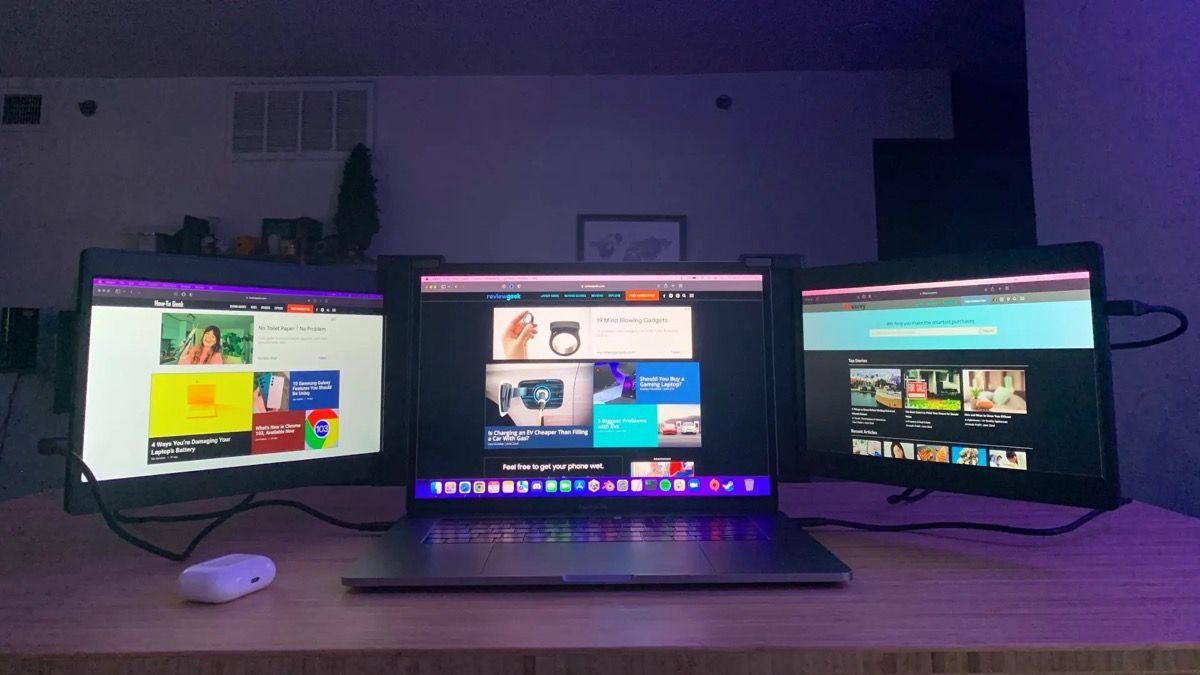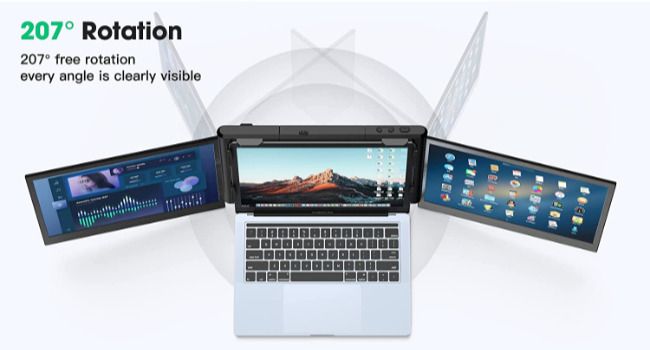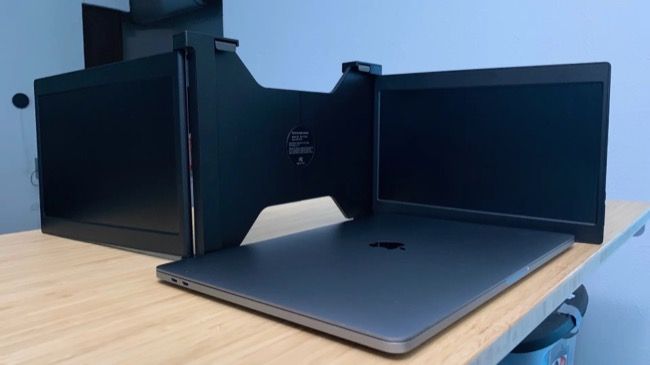Quick Links
Key Takeaways
Laptop screen extenders improve productivity by adding one or two additional displays to your laptop. They may be an ideal solution if you find a laptop limiting and don't mind the added weight, bulk, power drain, or cost a screen extender brings. Just confirm your laptop's compatibility before buying.
Your laptop gives you the freedom to work anywhere without needing to be shackled to a power outlet. This comes at the cost of a single display which can hamper productivity if you don't have the room or budget for a multi-monitor setup. A laptop screen extender can help solve that problem.
What Is a Laptop Screen Extender?
A laptop screen extender clamps onto the lid of your laptop, extending your screen real estate by one or two monitors. Some models add a single display to the left or the right of your laptop's built-in monitor, while others go the whole hog and have a monitor on either side for maximum use of space.
Whether you're using a Windows laptop or MacBook, these monitors appear to the operating system as any other monitor would. Effectively, you're adding one or two external monitors on either side of your main display. You can do things like set unique wallpapers, assign apps, and calibrate them accordingly.
The concept had a rocky start with a troubled Kickstarter launch in 2015 and a later Razer concept that never materialized. However, it turns out the idea of a clip-on triple-monitor setup for laptops is pretty solid, with third parties stepping in to make the dream a reality. Amazon is now awash with similar designs, with companies like Kwumsy and UPERFECT shipping real products into the hands of eager customers.
Review Geek reviewed the Fopo Triple Laptop Screen Extender in mid-2022, which demonstrates that the laptop screen extender has already reached the "no-name Amazon brand" stage, where you can get your hands on one relatively cheaply. If that model is anything to go by you do indeed get what you pay for.
More Monitors, More Productivity
The main benefits should be obvious right out of the gate: more monitors means more screen real estate. Adding more monitors to your setup is one of the easiest ways of increasing productivity. You'll spend less time shuffling between desktops and flicking between apps. The information or app you need is only a glance or a swipe away at any single time.
Just about every type of computer user can benefit from more monitors. This includes students or writers who skip from tab to tab and source to source, coders who want to work on one display while consulting documentation or a preview on the other, video editors who need dedicated spaces for a project library or clip and project playback, or gamers who like to play on one screen and participate in a Discord on the other.
Some are designed with multiple-user setups in mind, to make sharing ideas with colleagues, clients, or collaborators easier with huge angles of rotation.
Multiple monitors have traditionally been reserved for desktop setups but with the arrival of laptop screen extenders, you can now have a triple-monitor portable workstation setup. This is a great productivity booster and solves one of the biggest laptop drawbacks, but it's not without its problems.
A Bulky and Inelegant Solution
Most people pick a laptop because it's a lightweight and portable way to get work done. When you add two additional monitors plus some method of mounting them, your setup becomes noticeably less portable. Depending on the screen extender you choose, you'll likely need to detach the mount, fold up the monitors, stow them safely for transport, then repeat the whole process in reverse when you reach your destination.
This somewhat hampers the utility of the setup, but it doesn't remove it entirely. A laptop screen extender is a nice optional extra for times when you might need it. This could be a cramped home or dorm room desk, while studying for long hours in the library, or for use in a hotel room while traveling for work.
You probably won't want to use a laptop screen extender in a cozier setting, like when sitting on the sofa or a bed. Having one or two displays clamped onto your main display will introduce balance problems and make your laptop heavier than you might be comfortable with.
The best screen extenders have a single plug for everything, which includes connecting and powering both displays. This is another mark against portability since these displays will place a significant drain on your laptop battery. Most depend on your laptop for power, which means you should ideally be connected to mains power while using a laptop screen extender.
There are other things to consider, like the fact that you're not necessarily investing in the highest quality displays. We've not (yet) seen a screen extender with a refresh rate that goes beyond 60Hz, and you may want to temper your expectations when it comes to color accuracy, brightness, and contrast ratio. Most extenders seem to use IPS panels which provide good response times at the cost of contrast ratio.
The success and popularity of the concept will likely dictate the types of improvements we see. If the product remains niche, we may never see screen extenders with 175Hz refresh rates or QD-OLED panels.
Compatibility is another concern. Some laptops may require additional adapters or HDMI hubs if the built-in USB-C connection that adorns most screen extenders doesn't cut it. Make sure you check the reviews or are confident that your laptop has the right type of ports (and enough of them) to get the job done before you buy.
What Does a Laptop Screen Extender Cost?
At the cheaper end of the market, you have products like the Fopo Triple Laptop Screen Extender we mentioned earlier, for around $470. Review Geek noted that the price was competitive and the 1080p displays were clear and did the job. On the downside, there was inadequate protection for the left display during transport and the lack of a locking mechanism when mounting.
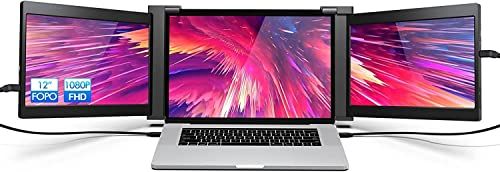
Fopo Triple Laptop Screen Extender
Expand your laptop with two additional 12-inch IPS displays with the Fopo Triple Laptop Screen Extender. It includes USB-C and HDMI connection, 1080p resolution, 178º viewing angles, and connection cables.
A pricier solution would be something like the Kwumsy P2 Pro which promises single-cable connection for MacBook Pro (M1 or later) owners and larger 13.3-inch displays (but the same 1080p resolution). Customer reviews on the whole are very positive, with many noting that the Kwumsy P2 Pro was less prone to issues than other cheaper models.
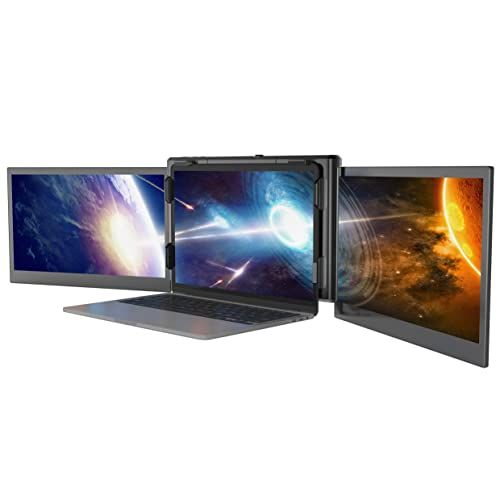
Kwumsy P2 Pro
A higher-end laptop screen extender from Kwumsy features dual 13.3-inch displays at 1080p, a USB-C with USB-PD, and a single cable connection for supported M1 or later MacBooks.
There are plenty of other choices of screen extenders to choose from online. You can go slightly larger with the FOPO 15-inch Triple Laptop Screen Extender (but still wrestle with the same 1080p resolution), or save some money with a single 14.1" ZTGD Screen Extender if you don't need three monitors.
Alternatives to a Laptop Screen Extender
The most obvious alternative to a laptop screen extender is a portable monitor. We've already covered our top portable monitor picks, with known brands like ASUS and ViewSonic featuring alongside budget choices. Generally speaking, you'll get more choices, better quality displays, a far greater range of resolutions (including 4K), and more freedom.
You can connect most laptop screen extenders to a source that isn't a laptop, but why would you? These displays are designed to be clamped to your laptop in use. This isn't the case with a portable monitor, which usually includes its stand, a built-in battery, and in some cases speakers. Some are factory calibrated for accuracy, like the Asus ProArt Display PA148CTV.
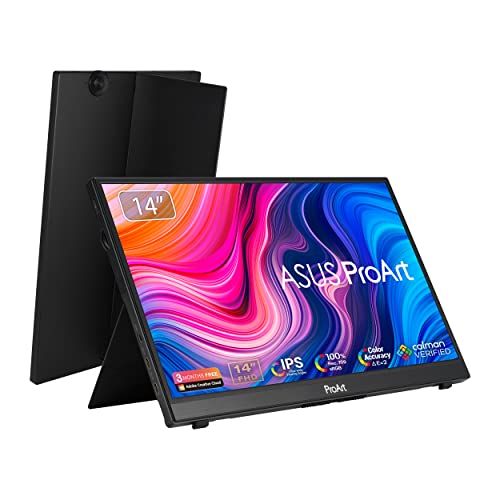
Asus ProArt Display PA148CTV
The Asus ProArt Display PA148CTV is a fantastic monitor for pretty much everything except gaming. If you want a dual-screen setup on the go for productivity, you can't go wrong with it.
These are an ideal choice if you don't mind carrying them around with you. They're often lighter and easier to carry than a screen extender, instead mimicking the form factor of a tablet. The drawback is that they don't sit as close to your main display, and will need to be positioned slightly to the left or right of your laptop (on a desk) to be useful.
If you have the desk space and the budget, you can't go wrong with a "real" multiple-monitor setup. The best solution is to build a dockable desk with a single point of connection (like a USB-C hub) for all your monitors. With the right combination of hub and laptop, you can charge and output to monitors with a single USB-C connection.
You Might Need a Laptop Stand Too
A laptop screen extender can greatly improve productivity, but craning your neck can cause problems in the longterm. You can solve this problem with a laptop stand, some of which double-up as docking stations.
If you go this route, you'll also need to invest in a decent keyboard (we recommend something mechanical) and a mouse (or a Mac trackpad) too.

